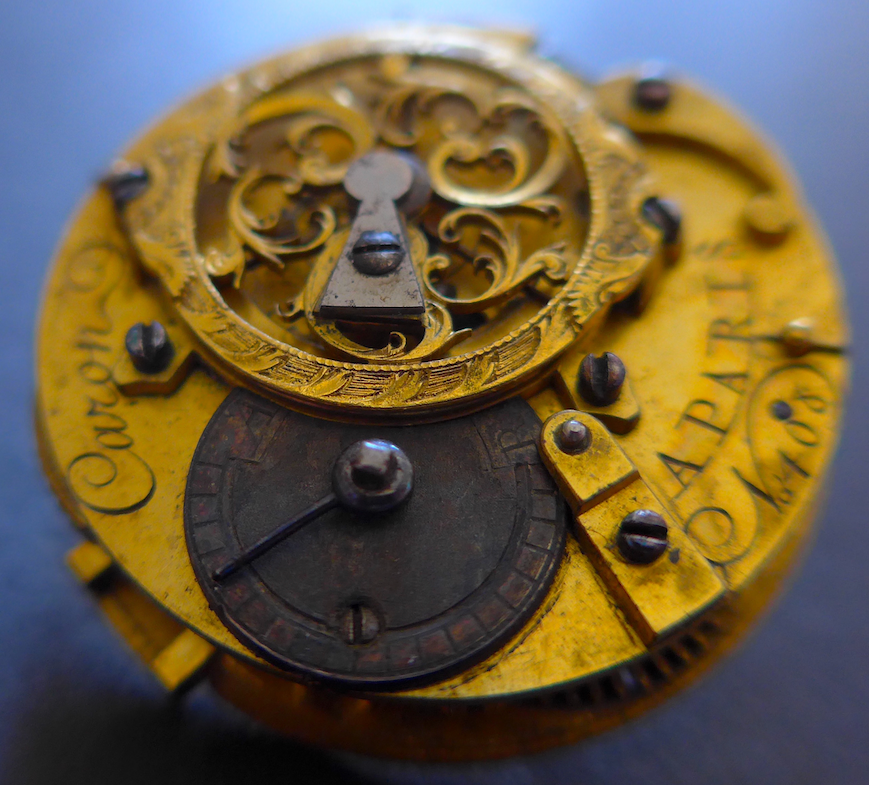

Description: Gilt brass, front wound, verge fusee movement (35mm diameter). Silver regulator dial and steel regulator hand, medium sized two-footed cock with steel cockerel. Featuring round pillars. Backplate signed ‘Caron A PARIS’ and numbered ‘No. 408’. Lacking motion work, dial and hands.
Additional Info:
André – Charles Caron (26. 04. 1698 – 23. 10.1775) was the master of Jean – Antoine Lépine. Not much is known about his personal life and very few pieces from his production have survived. Caron was associated with Lépine from 1756 and 1769 during which the pieces were supposedly signed ‘Caron et Lépine’, but none with this combined signature have survived. 1756 Lépine married Caron’s daughter Madeleine – François Caron. 1766 Lépine succeeded to Caron. André – Charles Caron was the father of the famous Pierre – Augustin Caron (later de Beaumarchais).
Pierre – Augustin Caron de Beaumarchais (24. 01. 1732 – 18. 05. 1799)

At various times in his life, he was a watchmaker, inventor, playwright, musician, diplomat, spy, publisher, horticulturist, arms dealer, satirist, financier, and revolutionary (both French and American).
It is transmitted that in In 1753, he invented the double virgule escapement and that Jean – André Lepaute then royal clockmaker in France had stolen the idea from him. Is known that Jean Romilly has already presented a virgule escapement in 1750 and later perfected the double virgule version. The double virgule system shows an additional row of pins showing downwards and activated by a second ‘virgule’ or comma shaped piece protruding from the balance staff. With a strategically perfect written letter, Beaumarchais managed to counter Lepaute’s statement, which made the court of Paris vote to his favour. This decision projected Beaumarchais into the focus of the wealthy at the court of King Louis XV. It is not surprising though that with his writing capabilities, Beaumarchais managed to build his own horological legend.
In 1755 Beaumarchais met Madeleine-Catherine Aubertin, a widow, and married her the following year. She helped Beaumarchais secure a royal office, and he gave up watchmaking. Shortly after his marriage, he adopted the name ‘Pierre – Augustin Caron de Beaumarchais’, which he derived from ‘le Bois Marchais’, the name of a piece of land belonging to his new wife. He believed the name sounded grander and more aristocratic and adopted at the same time an elaborate coat of arms. His wife died less than a year later, which plunged him into financial problems, and he ran up large debts.
An early French supporter of American independence, Beaumarchais lobbied the French government on behalf of the American rebels during the American War of Independence. Beaumarchais oversaw covert aid from the French and Spanish governments to supply arms and financial assistance to the rebels in the years before France’s formal entry into the war in 1778. He later struggled to recover money he had personally invested in the scheme. Beaumarchais was also a participant in the early stages of the French Revolution. He is probably best known, however, for his theatrical works, especially the three Figaro plays.
Due to the complexity of manufacture and the not much increased precision of the double virgule system, it got only rarely adopted. The watchmaker who used it most, was Jean – Antoine Lépine, who was the brother-in-law of Beaumarchais. Also few other watchmakers have used this type of escapement. Only five movements by Lépine bearing this escapement have survived.
